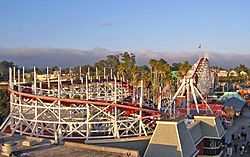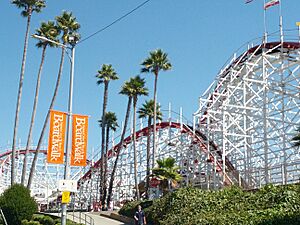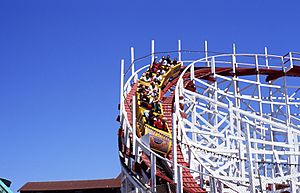Giant Dipper facts for kids
Quick facts for kids Giant Dipper |
|
|---|---|

Track overview from the Skyglider
|
|
| Santa Cruz Beach Boardwalk | |
| Location | Santa Cruz Beach Boardwalk |
| Coordinates | 36°57′53″N 122°00′55″W / 36.96472°N 122.01528°W |
| Status | Open |
| Opening date | May 17, 1924 |
| Cost | $50,000 |
| Designated: | 1987 |
| Part of: | Santa Cruz Looff Carousel and Roller Coaster |
| Reference #: | 87000764 |
| General statistics | |
| Type | Wood |
| Manufacturer | Arthur Looff |
| Designer | Frank Prior, Frederick Church |
| Track layout | Double Out and Back |
| Lift/launch system | Chain lift hill |
| Height | 70 ft (21 m) |
| Drop | 65 ft (20 m) |
| Length | 2,640 ft (800 m) |
| Speed | 55 mph (89 km/h) |
| Inversions | 0 |
| Duration | 1:52 |
| Height restriction | 50 in (127 cm) |
| Trains | 2 trains with 6 cars. Riders are arranged 2 across in 2 rows for a total of 24 riders per train. |
| Giant Dipper at RCDB | |
The Giant Dipper is a super old and famous wooden roller coaster. You can find it at the Santa Cruz Beach Boardwalk. This is a fun amusement park in Santa Cruz, California.
The Giant Dipper was built very quickly. It took only 47 days to finish! It opened on May 17, 1924. Building it cost $50,000 back then. This ride is 70 feet (21 m) tall and goes up to 55 miles per hour (89 km/h). It's one of the most popular wooden roller coasters in the whole world. By 2012, over 60 million people had ridden it! The Giant Dipper has won cool awards. These include being named a National Historic Landmark.
Contents
History of the Giant Dipper
Before the Giant Dipper, there was another roller coaster. It was called the Thompson's Scenic Railway. It was built in 1908. In October 1923, park managers decided to build a new ride. They wanted to replace the old Scenic Railway.
Arthur Looff got the permit to build the Giant Dipper in January 1924. He wanted to make a ride that felt like many exciting things at once. He imagined it would feel like falling down a mine shaft or flying in an airplane. It took about five months to take down the old ride and build the new one. The Giant Dipper officially opened on May 17, 1924.
Changes and Milestones
In 1974, the ride got a fresh coat of paint. It was painted in a classic Victorian style. In 1989, a big earthquake hit the area. It was called the Loma Prieta earthquake. Luckily, the Giant Dipper was mostly fine! It closed for about a month for safety checks. The park even held an event to help people affected by the earthquake.
In 2002, the Giant Dipper celebrated a huge milestone. Its 50 millionth rider took a spin! Ten years later, on July 27, 2012, it hit 60 million riders. The park gave out special prizes to the 24 people on the train that day.
Arthur Looff built the Giant Dipper. Frederick Church designed it. Building it needed a lot of materials. They used 327,000 feet (100,000 m) of lumber. They also used 743,000 nails and 24,000 bolts! The powerful 70 horsepower motor is still used today.
What It's Like to Ride
When you get on the Giant Dipper, the ride starts right away. Your train goes into a dark tunnel. Inside the tunnel, you'll go through some small drops and turns. Then, the train comes out and starts climbing the big lift hill.
Once you reach the top, you're 70 feet (21 m) high! Then, you drop 65 feet (20 m) down. You'll reach a super fast speed of 55 miles per hour (89 km/h)! After the big drop, the train goes up into a banked turn to the left. You'll then go over two more hills. These are right next to the lift hill.
Next, the train makes a big turn around. This turn is right over the tunnel you started in. Then, you'll go over three more small hills. These are also near the lift hill. After another turn around, you'll go over three final small hills. Then, the train slows down on the brake run and your ride is over!
How the Giant Dipper Works
The Trains
The Giant Dipper uses two trains. Each train has six cars. In each car, two people can sit side-by-side in two rows. So, a total of 24 riders can be on one train. The trains were made by Dana Morgan.
When the Giant Dipper first opened, it had three trains. Each train had ten cars. Over the years, the trains have been updated. But they still look very similar to how they did in 1924. The trains have also changed colors a few times!
The Track
The wooden track is about 2,640 feet (800 m) long. The highest point of the ride, the lift hill, is about 70 feet (21 m) tall. The track itself is painted red. The wooden supports that hold it up are white. When it was built, they used 327,000 feet (100,000 m) of lumber for the track. The track is checked every two hours to make sure it's safe!
A True Roller Coaster Legend
In the early 1970s, the Giant Dipper became very special. It was the last "classic roller coaster" left between Vancouver, British Columbia and San Diego, California. It's also one of only three roller coasters designed by Frederick Church that are still running. The other two are the Dragon Coaster and the Giant Dipper in Belmont Park.
The Giant Dipper is one of the few roller coasters still operating from what experts call the "golden age of roller coasters." It's the oldest roller coaster in California. It's also one of the oldest roller coasters still running anywhere in the world!



